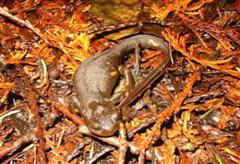Newt - Rough Skinned
Scientific Name: Taricha granulosa
Mon, 28th April, 2025 - 7:59 am GMT
Sponsor Ads:

Alternative Name
Scientific Name: Taricha granulosaBasic Info
By maturity, Rough Skinned Newts can measure up to 8 inches, although the tail makes up more than half that length. With bumpy skin, the Rough Skinned Newt is a dark or light shade of brown or black. Its underside may be orange or yellow. The lower eyelid of this salamander is dark, and the teeth of its upper lip are in a V formation. They lack costal grooves and their limbs are comparatively long. Male Rough Skinned Newts have longer tails, legs, and more swollen vents than most females. Because Rough Skinned Newts have very poisonous skin secretions, they can cause death when ingested in sufficient quanties.
Health
The Rough Skinned Newt secretes a poisonous substance, so after handling these animals you should wash your hands well, and be careful not to touch your eyes. Breeding Usually, male Rough Skinned Newts get smoother skin around breeding season. They become more aquatic, and develop larger tail fins and pads on their soles and palms. Rough Skinned Newts come to the same breeding areas year after year. They locate them by smell. Usually this occurs between February and April, although salamanders living in higher elevations may not breed until July. During mating, male Rough Skinned Newts compete for females and may direct the female away from other males using their tails. After amplexus, the male newt lays a spermatophore in the water that the female will pick up with the male's help. Afterward, amplexus recommences, which prevents the female from mating with another male. Rough Skinned Newts generally lay their eggs along the edges of permanent waterways, attached to some vegetation. Rough Skinned Newt larvae require one or two seasons to pass before they transform into their adult form.Habitat
Generally, Rough Skinned Newts may be found in elevations between sea level and 9,000 feet. During the day, they hide under rocks, logs, or leaves. Most often, they are found near permanent bodies of water, especially swamps near the edges of forests.Behavior
Lacking the overall sliminess that many people believe is characteristic to salamanders, the Rough Skinned Newt has warty skin instead. These interesting animals are very poisonous if ingested, but they can be handled and may often be quite docile. Rough Skinned Newts become quite aquatic during breeding season and even afterward throughout the summer. They have bright colored undersides to warn predators that they are poisonous, and when alarmed they will point their heads and tails into the air while wiggling their bodies. The Garter Snake can resist the Rough Skinned Newt's poison, and can prey upon these animals. Apart from its alarm display, the Rough Skinned Newt is generally a slow moving and docile salamander.Origin
Pacific NorthwestHistory
The range of Rough Skinned Newts encompasses much of the Pacific Northwest. They are found more often along the coastal areas of this region through the United States and Canada.Common Foods
Active even in daytime, Rough Skinned Newts feed on invertebrates like slugs, worms, and aquatic insects. Sometimes, they will eat tadpoles.Sponsor Ads:
Smoking is, as far as I am concerned, the entire point of being an adult. Many people find smoking objectionable. I myself find many --even more-- things objectionable. I do not like aftershave lotion, adults who roller-skate, children who speak French, or nayone who is unduly tan. I do not, however, go around enacting legislation and putting up signs. --Fran Lebowitz
Newt - Rough Skinned
Coded by: BGID® | ALL RIGHTS RESERVED Copyright © 2000-2025
Disclaimer | Privacy | Report Errors / Contact | Credits
















